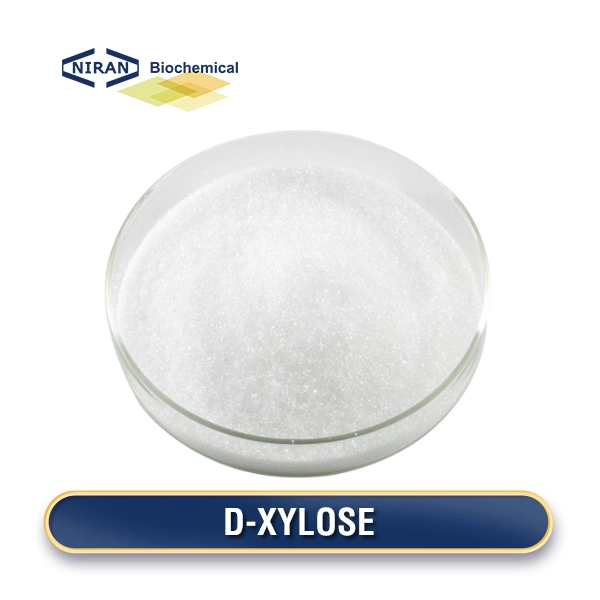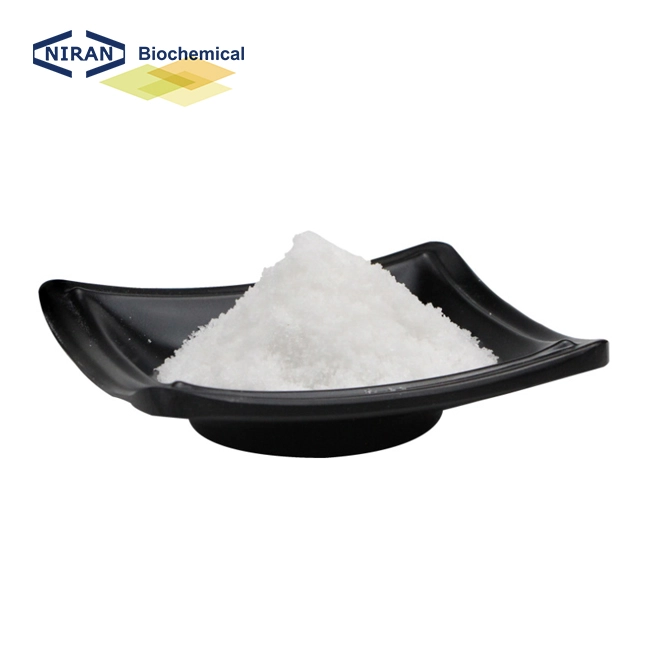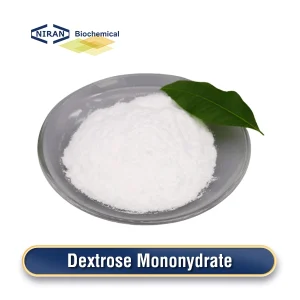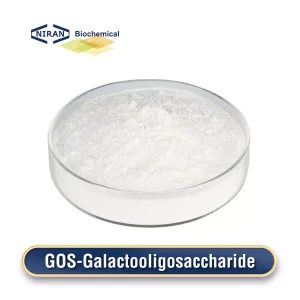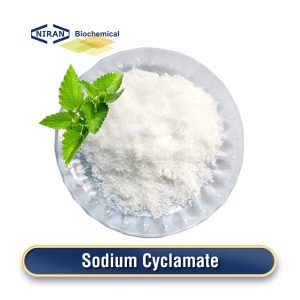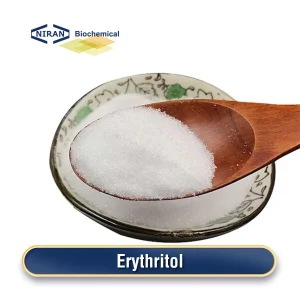Niran Biochemical
YOUR RELIABLE FOOD INGREDIENTS
Send Inquiry
Home » Products » Sweeteners » D-Xylose
D-Xylose
- CAS: 58-86-6
- Chemical Formula: C5H10O5
- Certification: KOSHER, ISO, HALAL, FSSC22000, BRC, etc.
- Standard: USP/BP
- MOQ: 1000KG
- Shelf Life: 2 Years
Inquire Product
Product Description
What is D-Xylose?
D-xylose is a pentose formed by hydrolysis of hemicellulose-rich plants such as sawdust, straw, and maize cobs. It appears as colorless to white crystals or white crystalline powder on the surface, with a little unique scent and pleasant sweetness. Its sweetness is about 40% of sucrose, and it has a wide range of uses in food, feed, medicine and other industries.
The production of D-xylose can be done by extracting xylan from plant materials, converting it into D-xylose through acid hydrolysis, and then going through the steps of neutralization, filtration, decolorization, desalination, concentration, crystallization and drying to finally obtain a high-purity D-xylose product.
Related parameters:
| Items | Standards |
| Assay(dry basis) | 98.0%-102.0% |
| Loss on drying,% | ≤0.5 |
| Specific optical rotation,° | 18.5-19.5 |
| Heavy metals,mg/kg | ≤5 |
| Arsenic, mg/kg | ≤0.5 |
| Lead, mg/kg | ≤0.5 |
| Chloride,% | ≤0.005 |
| Sulphate,% | ≤0.005 |
| Sulphated ash,% | ≤0.05 |
| Melting point, ℃ | 147-151 |
| pH in aqueous solution | 5.0-7.0 |
| Total plate count,CFU/g | ≤100 |
| Coliform,MPN/g | ≤3 |
| Yeast&Mold, CFU/g | ≤100 |
Recommended dosage:
| Food name | Maximum usage(g/kg) |
| Carbonated drinks | 3 g/kg |
| Fruit drinks | 3 g/kg |
| Yogurt | 2 g/kg |
| Milk | 2 g/kg |
| Cake | 6 g/kg |
| Chocolate | 3 g/kg |
| Soy sauce | 2 g/kg |
| Vinegar | 2 g/kg |
| Ketchup | 3 g/kg |
| Ham | 2 g/kg |
| Sausage | 2 g/kg |
| Bacon | 2 g/kg |
| Puffed food | 3 g/kg |
| Nuts | 2 g/kg |
| Instant noodle seasoning | 2 g/kg |
| Lactic acid bacteria drinks | 3 g/kg |
| Fermented milk drinks | 3 g/kg |
| Fruit drink powder | 3 g/kg |
| Protein powder | 4 g/kg |
D-Xylose has a wide range of uses
1. Used to correct flavor, color and enhance aroma in meat processing and heat-processed grain products
D-xylose is a reducing sugar that is good at neutralizing amino acids in sugars to produce Maillard reaction. It can be added to food in any proportion as needed. A small amount of xylose can achieve the effect of coloring and enhancing aroma. It is now widely used in fish paste products, baked foods, biscuits, ham, sausages, bacon, aquatic products, artificial meat, and meat food processing. After adding a small amount of xylose and heating, the color, flavor and aroma of meat products can be improved, and the odor of meat can also be adjusted. In this regard, xylose has a better effect than glucose or sucrose.
2. Production of meat flavors and pet feed
Meat flavors produced at home and abroad mainly use meat enzymatic extracts as the base material, and then add amino acids and sugars to heat and produce Maillard reaction, which can obtain realistic natural meat flavors, including egg yolk flavor, seafood flavor, etc. At present, the proportion of xylose as the raw material in such flavors used is relatively large.
3. Non-caloric sweetener
Suitable for obese people and those with high sugar levels. D-xylose is mainly absorbed passively in the empty space during metabolism in the body, and 90% is excreted from the body without causing diarrhea, so it is an excellent nutritional sweetener.
4. D-xylose is a very food-compatible substance. A tiny quantity of xylose added to food can have positive results.
5.Used to prepare xylitol.
User asked question:
Q: Are D-xylose and xylitol the same?
A: D-xylose is a monosaccharide belonging to the aldose class. It is reductive and can participate in the Maillard reaction. Its sweetness is about 40% of sucrose. It has a lower sweetness and can be partially absorbed and metabolized by the human body. It has a lower calorie content and can be used as a functional sweetener, a raw material for the Maillard reaction, a pharmaceutical excipient, a prebiotic, and a raw material for biomass conversion.
Xylitol is a product of D-xylose reduction. It belongs to the sugar alcohol class. It has a sweet taste and a sweetness close to sucrose, about 70% to 100% of sucrose. It has a cool taste and is not prone to tooth decay. It does not participate in the Maillard reaction and is not completely metabolized by the human body. It doesn’t alter blood sugar levels and contains roughly 60% sucrose as calories. It is suitable for diabetics and low-calorie diets and is widely used in sugar-free foods, diabetic foods, chewing gum, toothpaste, mouthwash, and medicines.

